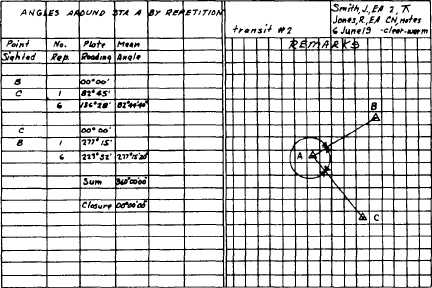Figure 13-15.-Notes for the angle around a station, repeated six times.
on the A vernier is about twice the size of the
actual angle measured. The effect of this is to
halve the total possible error. This error was
originally plus or minus 30 sec. Now, the error
is plus or minus only 15 sec.
If you measure this angle a total of six times,
the total possible error will be reduced to one-sixth
of 30 see, or plus or minus 5 sec. In theory, you
could go on repeating the angle and increasing the
precision indefinitely. In actual practice, because
of lost motion in the instrument and accidental
errors, it is not necessary to repeat the angle more
than six times.
The observation may be taken alternately with
the telescope plunged before each subsequent
observation. But a much simpler way is to take
the first half of the observations with the telescope
in the normal position, the other half, in an
inverted position. In the example given above, the
first three readings may be taken when the
telescope is in its normal position; the last three
when it is in its reversed position. To avoid the
effect of tripod twist, after each repetition, rotate
the instrument on its lower motion in the same
direction that it was turned during the measure-
ment; that is, the direction of movement should
always be either clockwise or counterclockwise.
Measuring angles by repetition eliminates
certain possible instrumental errors, such as those
caused by eccentricity and by nonadjustment of
the horizontal axis.
Figure 13-15 shows field notes for the angle
around a station, repeated six times. The angle
BAC was measured six times, and the angle
closing the horizon around station A was also
measured six times. The first measurement is not a
true repeat, but it is counted as one in the column
headed “No. Rep.” (number of repetitions).
With the transit first trained on B and the
zeros matched, the plate reading was 00°00´. This
is recorded beside B in the column headed “Plate
Reading.” The upper motion clamp was then
released, the telescope was trained on C, and a
plate reading of 82°45´ was obtained. This reading
is recorded next to the figure ‘‘1” (for “1st
repetition”) in the column headed “No. Rep.”
The measurement of angle BAC was then repeated
five more times. After the final measurement, the
plate reading was 136°28´. This plate reading is
recorded as the sixth repetition.
Now to get the mean angle, it is obvious that
you need to divide some number, or figure, by
the total number of repetitions. The question is,
what figure? To determine this, you first multiply
the initial measurement by the total number of
repetitions. In this case, this would be as follows:
Next, you determine the largest multiple of 360°
that can be subtracted from the above product.
Obviously, the only multiple of 360° that can be
subtracted from 496°30´ is 360°. This multiple is
13-14

